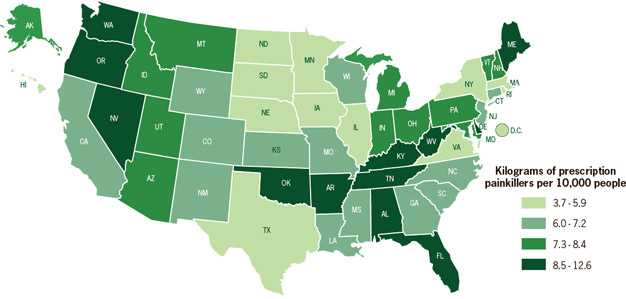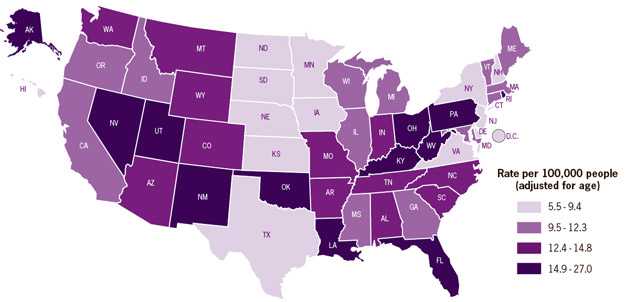Prescription Painkiller Overdoses in the US infographic
Rates of prescription painkiller sales, deaths and substance abuse treatment admissions (1999-2010)

SOURCES: National Vital Statistics System, 1999-2008; Automation of Reports and Consolidated Orders System (ARCOS) of the Drug Enforcement Administration (DEA), 1999-2010; Treatment Episode Data Set, 1999-2009
This chart shows the rates of prescription painkiller sales, deaths, and treatment admissions in the United States. The rate of prescription painkiller sales increased from less than two kilograms per 10,000 people in 1999 to more than seven kilograms per 10,000 people in 2010. The rate of prescription painkiller deaths from increased from less than two deaths per 10,000 people in 1999 to more than 4 deaths per 10,000 people in 2008. The rate of prescription painkiller treatment admissions increased from less than one treatment admission per 10,000 people in 1999 to more than four treatment admissions in 2009.
Amount of prescription painkillers sold by state per 10,000 people (2010)

SOURCE: Automation of Reports and Consolidated Orders System (ARCOS) of the Drug Enforcement Administration (DEA), 2010
This figure shows the amount of prescription painkillers sold by state per 10,000 people in 2010. States with the highest amounts of prescription painkillers sold, 8.5 to 12.6 kilograms per 10,000 people, include: Washington, Oregon, Nevada, Oklahoma, Arkansas, Maine, Delaware, West Virginia, Kentucky, Tennessee, Alabama, and Florida. States with 7.3 to 8.4 kilograms of prescription painkillers sold per 10,000 people include: Alaska, Montana, Idaho, Utah, Arizona, Michigan, Indiana, Ohio, Pennsylvania, Vermont, New Hampshire, and Maryland. States with 6.0 to 7.2 kilograms of prescription painkillers sold per 10,000 people include: California, Wyoming, Colorado, New Mexico, Kansas, Missouri, Wisconsin, Louisiana, Mississippi, Connecticut, New Jersey, North Carolina, South Carolina, and Georgia. States with the lowest amounts of prescription painkillers sold, 3.7 to 5.9 kilograms per 10,000 people, include: Hawaii, North Dakota, South Dakota, Nebraska, Texas, Minnesota, Iowa, Illinois, New York, Massachusetts, Rhode Island, Virginia, and Washington, D.C.
Drug overdose death rates by state per 100,000 people (2008)

SOURCE: National Vital Statistics System, 2008
This figure shows drug overdose death rates by state per 100,000 people (adjusted for age) in 2008. States with the highest drug overdose death rates, 14.9 to 27.0 deaths per 100,000 people, include: Alaska, Nevada, Utah, New Mexico, Oklahoma, Louisiana, Florida, Kentucky, West Virginia, Ohio, Pennsylvania, and Rhode Island. States with drug overdose death rates of 12.4 to 14.8 deaths per 100,000 people include: Washington, Montana, Wyoming, Colorado, Arizona, Missouri, Arkansas, Indiana, Tennessee, Alabama, North Carolina, and South Carolina. States with drug overdose death rates of 9.5 to 12.3 deaths per 100,000 people include: Oregon, California, Idaho, Wisconsin, Michigan, Illinois, Mississippi, Georgia, Maine, Vermont, Massachusetts, Connecticut, and Maryland. States with the lowest rates of drug overdose deaths, 5.5 to 9.4 deaths per 100,000 people, include: Hawaii, North Dakota, South Dakota, Nebraska, Kansas, Texas, Minnesota, Iowa, New Hampshire, New York, New Jersey, Delaware, Virginia, and Washington, D.C.
- Page last reviewed: November 1, 2011
- Page last updated: November 1, 2011
- Content source:
- National Center for Injury Prevention and Control, Division of Unintentional Injury Prevention
- Page maintained by: Office of the Associate Director for Communications (OADC)


 ShareCompartir
ShareCompartir